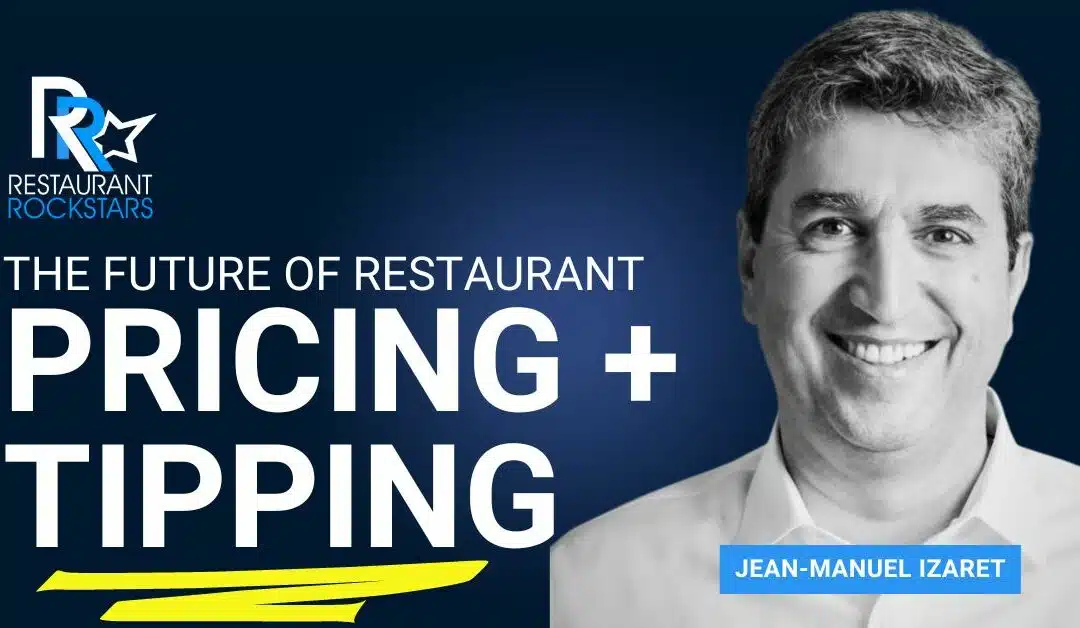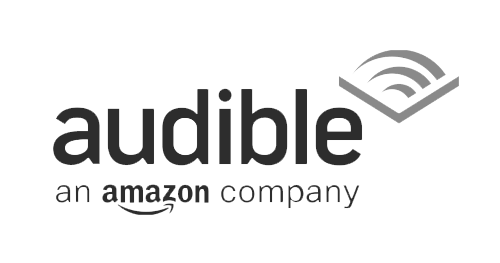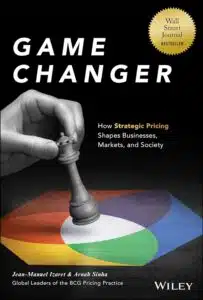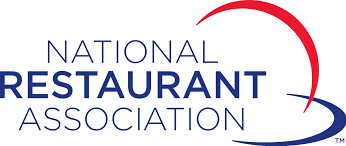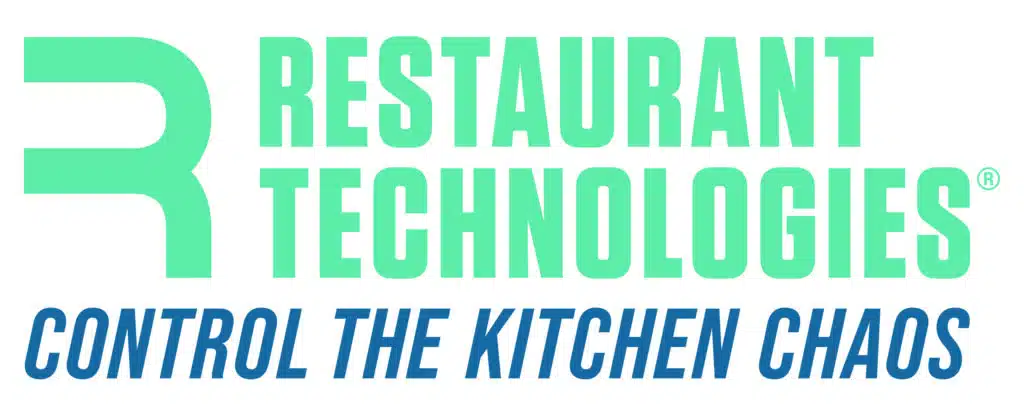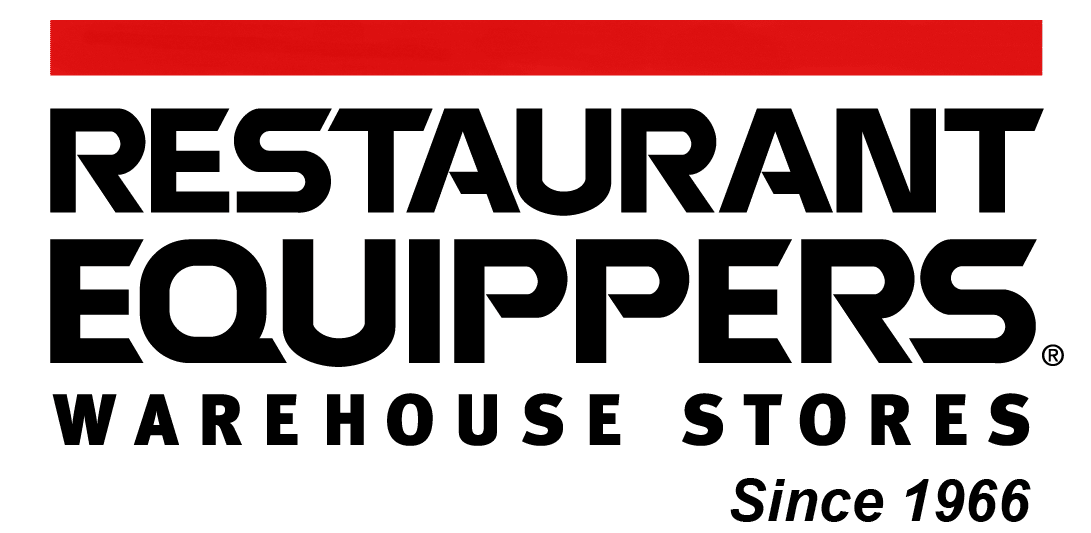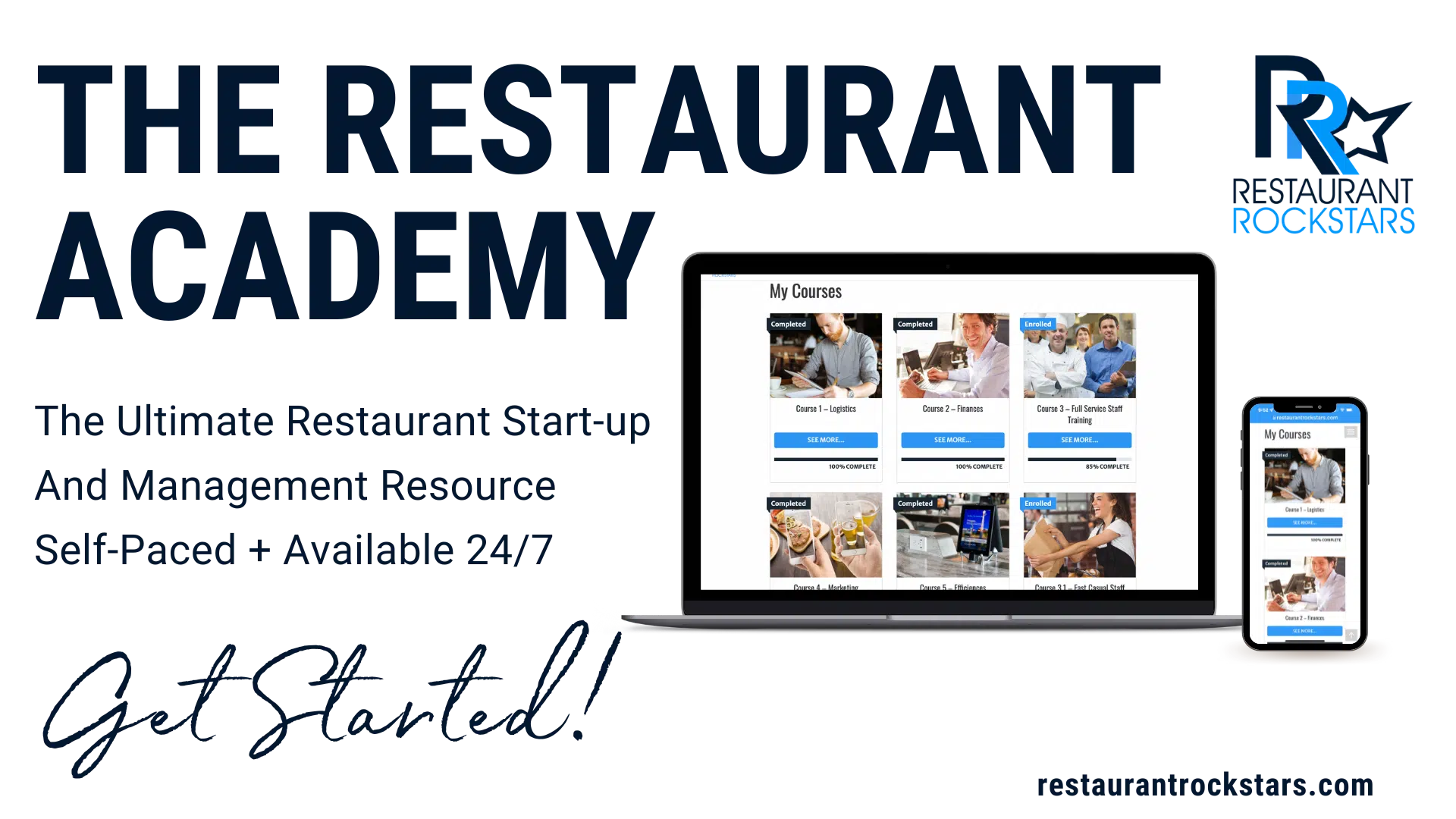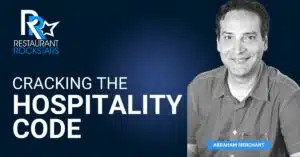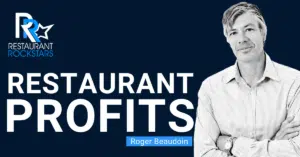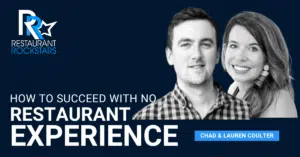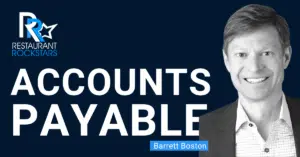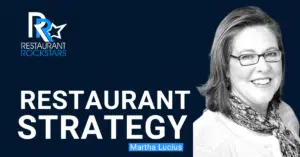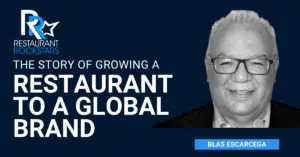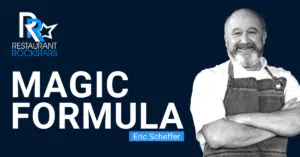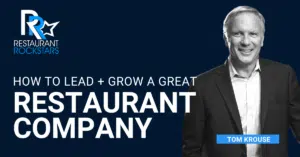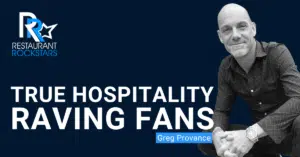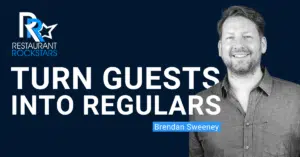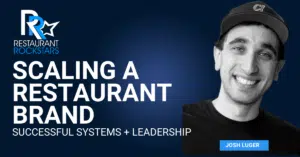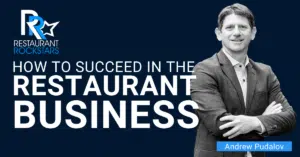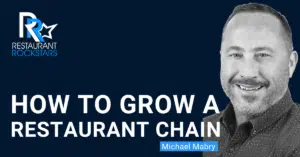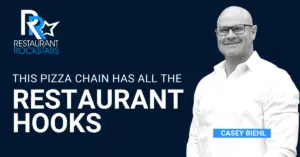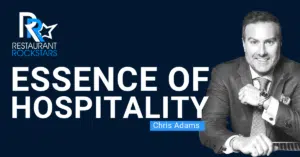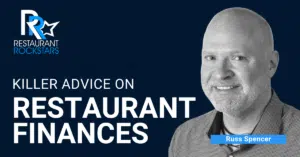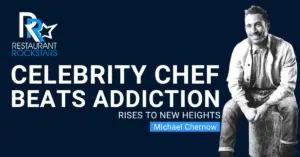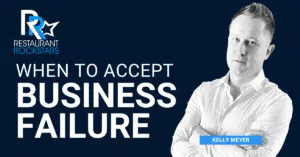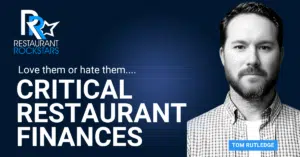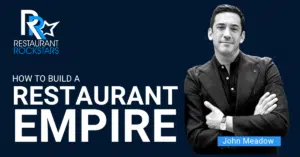Restaurant Rockstars Episode 388
The Future of Restaurant Pricing Strategies and Tipping
LISTEN HERE OR ON YOUR FAVORITE PODCAST PLAYER
It’s getting harder and harder to provide true value to our guests with labor, challenges, inflation, and high labor costs. This makes your restaurant pricing model critically important.
Tipping has also been a challenging restaurant issue. Earning differences between front and back of house, controversy surrounding surcharges on the bill and the list goes on…
In this episode of the Restaurant Rockstars Podcast I speak with Jean-Manuel Izaret of Boston Consulting Group all about the future of restaurant pricing strategies and tipping.
Listen as my guest Jean-Manuel Izaret provides his expert take on:
- Restaurant pricing and tipping strategies
- Finding the balance between menu price, raising prices, value to the guest and your restaurant profit
- Restaurant pricing that includes surcharges and added fees to the guest – does it make sense?
- The movement to eliminate the “tipped wage” in restaurants.
- Sharing the wealth between front and back of house
And of course, Jean-Manuel Izaret’s new book: “Game Changer”, all about pricing strategy.
Listen, I’ve been talking about our Restaurant Profit Maximizer… it’s a powerful course that can immediately boost your restaurant’s bottom line!
For just $7, The Restaurant Profit Maximizer course will show you proven ways to boost profit in your restaurant. Check it out – https://restaurantrockstars.com/sp/restaurant-profits and then go Rock YOUR Profits and YOUR Restaurant!
Roger
Connect with our guest:
Welcome back to the podcast. You’ve probably heard me talk about a restaurant profit maximizer course, and it’s certainly something that will really impact your bottom line if you check it out. With rising costs, especially for labor and inflation, you can’t control these things.
One thing you can control is your restaurant profit, and in this short but powerful course, I teach you all the ways that you can immediately impact your restaurant’s bottom line and increase your profit. Interestingly, I just got a great quote from one of our podcast listeners, and she says, Hi Roger, I just finished your Restaurant Profit Maximizer course.
I thoroughly enjoyed it and learned so much. I just wanted to thank you for what you do. We’re about a year and a half from opening, but when we get closer to opening our restaurant, I will definitely subscribe to your Restaurant Rockstars Academy. So don’t go anywhere. . Once again, thank you.
That’s signed Lisa H. Thanks Lisa. This week’s guest is Jean Manuel Izaret, and he is with Boston Consulting Group, very prestigious firm, and he has done extensive research on the pricing models in restaurants. Now, that’s really challenging because we have to continually add value to our guests experience, especially during .
Times of short labor, while continually raising prices to keep up with inflation, of course, and rising labor costs. So how do we strike that balance? This conversation is going to dive deep into that, and we’re going to talk about that value and pricing, but we’re also going to cover the tipping issue in restaurants, which can be really contentious.
So stay tuned. Don’t miss this episode. Listen on.
You’re tuned in to the Restaurant Rockstars Podcast. Powerful ideas to rock your restaurant. Here’s your host, Roger Beaudoin.
Listen, from one restaurateur to another, and I hope you GMs out there listening as well are paying attention, you know, marketing should never be an experiment, oh, I tried this or I tried that, no, any of your valuable dollars that you spend on marketing should absolutely be trackable, you should know exactly what you’re doing.
where the business is coming from, and that it’s driving return on your investment. You spend a certain amount of money, you want to make far more money in return from that marketing, if you can track it. So pay attention. My friend Dyson runs a business called The Birthday Club, and his program is done for you.
Because we know that everybody dines out on their birthday. It’s a tradition. It’s a celebration. But not only do they not come in by themselves, they bring many friends with them. They usually have free spending and large check averages. It’s very profitable business. So why leave it to chance? Why let your competitors get all the birthday business?
So again, the birthday club is a done for you program. All you have to do is check out www.jointhebirthdayclub.com/birthdayRockstar. It’s a great program. If I still owned and operated restaurants today, after decades, it’s something I would definitely be doing, but it’s worth checking out.
So check it out. www.jointhebirthdayclub.com/birthdayRockstar
Rockstars, when I needed equipment for my former restaurants, I called Restaurant Equippers. Restaurant Equippers has served independent food service operators just like you going on 60 years. You’ll find all the top names and extensive inventory at their huge warehouse stores in Ohio, Michigan, and New Jersey.
You can shop Equippers. com or call their National Order Office at 800-235-3325. Their experienced specialists will help you get the best equipment and supplies and save you money. Thousands of name brand products are available for immediate store pickup or shipment. Just like me, when you need something, you need it now.
Restaurant Equippers will make sure you get the equipment and supplies you need, when you need them, at a price you want to pay. They shop the world to find the best products and value. Give Restaurant Equippers a call for all your equipment and supply needs or check their website, equippers.com.
Welcome back, everyone. This is the Restaurant Rockstars podcast. Thanks for being here. My guest, Jean Manuel, how are you today? Very good, Roger. Thank you very much for having me. I’m excited to have you here. This conversation is going to be all about pricing strategy and tipping in restaurants and hospitality venues.
And you’ve got expertise in this area. You’ve spent a lot of your career analyzing different industries and pricing models and you came to me as a pricing strategy expert, so I’m really excited to talk about this. It’s been somewhat of a, it’s an interesting topic. It’s somewhat controversial.
There’s a lot of depth to it, and I can’t wait to get into all of it. But before we do, just give us a little bit of your career trajectory. Tell us where you’ve been and what you’ve done and how came to this podcast.
Thank you for having me, Roger. I really appreciate it. Where I come from is first people might recognize the French accent.
I’m a French guy. I started my career in France, but I came to the U. S. more than 24, 25, 24 years ago now. From a business perspective, I started working for gas stations and Shell in France. And that’s where I started to do pricing work. And pricing gasoline can seem very boring.
And that, that’s the way I thought about it at the beginning. How much do you have but I discovered that the prices need to be different for every single station, depending on where they are a little bit like we’ll see for every hotel or restaurants, depending on where you are, you’re going to, you’re going to price differently.
And it was a great learning experience. I spent a few years in jail for a year and a half, almost five years. And then I moved to finish my PhD in marketing. And then after that I joined BCG first in Spain. And then I came to the U. S. in 1999.
Okay, so BCG is Boston Consulting Group, a lustrous global company that specializes in all types of industries and in helping businesses find more profits, solve business challenges, so were you specifically involved in pricing there, or did you run the gamut of different business solutions for different clients?
I started as anybody starts at BCG without any specialization whatsoever, and I worked for airlines, I worked for a hospital, I worked for an insurance company and so I worked for all sorts of companies at the beginning but progressively when I moved to the U. S. and I lived in in the Bay Area, I started to focus more on the technology space and more on the pricing topic because pricing was really important for for the technology space.
I, we can come back to that and then progressively instead of focusing just on on the industry technology, I decided to focus on the topic, which is pricing and starting around 2004/2005 I started to mostly do pricing work and I did this across industries from the consumer space and it did the hospitality and restaurant environment was one of the areas where I did a little bit of work but also in financial services.
in insurance companies, in airlines, in retail, and you know of course technology and industrial goods. So basically I’m a guy who’s done pricing, for more than 20 years now and that’s why I wrote this book. Just, I don’t know anything else but I wanted to share a few ideas about what I observed across the years of pricing.
As long as you brought it up, you just, you did just publish a book. It’s called Game Changer. Do you have a copy of it that you could just hold up, I’m curious about?
Yes.
Okay. There you go. Game changer. Fantastic. Give us an overview of, the different chapters and what someone can learn reading the book.
The main thing I observed is the understanding people tend to have about pricing is one where they see this as. One discipline that is very technical and quite complicated, but it’s mainly one thing. It’s just supply and demand. And and that’s how people imagine because that’s the way it is taught.
Both in on TV, when people talk about prices, they have one view about, oh, it’s just a supply and demand discussion. And when you study it in college Econ 101 is just that. Basically about that. And what I discovered working on pricing is that there’s a lot more complexity in how you set prices and What I distill in the book is I think there are seven types of situations Seven types of games if you wish that we describe it’s really like a sport So trying to do pricing is just right if you say I just want to be good at the ball sport which ball sport are you really good at?
Are you good, are you trying to be good at baseball or basketball or soccer or football? All these sports are very different. And in different business environments, you have different types of pricing exercises. And in some places, pricing is just going to be based on your costs and you just need to add your cost.
That’s in the construction business. If you build a house how much work does it take and material to build a house? That’s basically pricing for for building in constructions. But other places when you price a luxury watch has nothing to do with the cost. And it’s all about the value that consumers will see in the brands.
And so there are seven games. Maybe we’ll come into what some of them are. As we go, but I’m describing different situations and describing how people should price differently in these different situations. And that’s why it’s a game changer, because sometimes people think they are in one game, but they should be in another game.
Oh, that’s very interesting. Oh, thanks for sharing that. As long as we’re talking about pricing, obviously there’s guest perceptions. When you walk into a restaurant, depending on on the genre of the restaurant, if it’s a five star, white tablecloth, fine dining restaurant, you expect a certain level of service, you expect a certain quality of product, and a certain pricing tier.
And I think that’s more in line with a luxury watch where there’s an image or an aura attached to going to a certain restaurant. So that’s at the upper end. And then you’ve got the lower end, of course, where people are more value oriented and the product quality isn’t so high. Maybe the service is good, but the products, so everywhere in between, but mostly we’re talking about.
changing the landscape of gratuites in restaurantss and that is such a big deal and sort of a controversial topic and that is such a big deal But now, we’re going and where it’s going and the ins and outs of it. Let’s get into a real deep dive into this topic, because it’s Fascinating And there are restaurants that are successfully implementing this. I think Danny Meyer’s restaurant group comes to mind. I’ve heard of, Union Square Restaurant Group, I think, pioneered this, at least in the New York City area.
And he’s obviously gone on to build his business. But that’s really the only thing I know about this. And you’re the expert. So take us through the whole thing, the history, where it’s going, what it means, and how it’s changing the landscape.
Yes, it’s been a fascinating story. I dived a little bit into this and and going back into the history has been really helpful for me.
So first, as a European moving into the United States, one of the first things you were taught is when you go to restaurants, be generous on tipping. And that’s why that’s because you have the same words. In Europe, tipping exists in the same way, but the magnitude of the tipping is very different, and the purpose of the tipping is very different.
And in the US you get to understand that for many restaurant workers tipping is most of their income, whereas in Europe, it’s going to be a complement to their income. And it actually works in the way, The tipping is translated in French or German, for instance. In German it’s trinkgeld, in French it’s pourboire, and that’s what tipping means.
And trinkgeld means money for drinking, and pourboire is exactly the same thing. So it basically means, it’s, we give you a little bit of money so you could have fun on Friday. And and have a bit extra money to spend to drink. Whereas in the U S the tradition has come to to be so that big and a large proportion of the income will come from the tipping for service workers.
So where did that come from? I was so surprised to, to understand where that, that, that came from. I had heard that, the Americans liked the way the Europeans were doing this and they imported that, that practice into the US. The, what I discovered, and many people knew this, but for me it was a discovery.
Is that the start of the tipping history as different from Europe came after the end of the Civil War. And it basically came as some business owners decided that it’s still, and I’m going to interpret here but didn’t want to pay service workers who often happened to be black service workers.
And that’s of course different in different parts of the country and so on. There’s all sorts of subtleties there. But the essence is. They decided that they wanted to put the burden of paying for the employees, the service workers, to the customer and not to the company themselves. Of course, one of the logic is we’re going to incentivize the service workers to do the best work they can do.
And that had positive impact positive impact over time. As we know service workers tend to be much friendlier in the United States to than Paris, for instance, if you just take a comparison with the French people and the reputation of the French is they’re not necessarily service workers that friendly, they could throw the coffee on the table and you need to catch it and be happy about that.
So there’s some positive aspects to this from an incentive perspective, but it is also, as you give the customers the choice about how much they pay different service workers. All the psychological biases that customers have are projected on top of that. And one of the things that we know and has been has been studied many times is you tend to tip people who look like you slightly more than people who look differently from you.
And since there are more white customers than black customers, to make things simple in black and white here then structurally, on average, white people will tip a little more white service workers than black service workers. So structurally, you have some inequalities that come in there. You also have all sorts of inequalities between men and women, between Latinos, and not like all the biases, the psychological biases that we know people have essentially are projected into the pay.
That people receive. You have all sorts of other things about depending on what type of people work in different places and so on that, that have an impact. But basically, shifting the burden of paying the employees largely to customers essentially projects the biases that customers have. Of course, not all customers have the same biases.
And so some people might do the reverse to what I just described and so on, but I was just describing general averages. And it’s been and it has been proven that the amount of pay was that differences happen even independently from when you correct for the quality of the service, if you wish, which is, of course, important to, to take into account.
And so it’s it’s part of the many things. that are in American society and in other societies about structural biases that that you would have. And therefore there’s been a movement to try to correct that by having a lower proportion of the income being just due to tips and having more put into the fixed wages that service people might have.
In European countries, at least France and Italy, where I’ve been to several times, it is a career position. You’re a waiter, and that is your career, and you are paid a salary to be a waiter, right? And in some countries, I’m thinking Italy specifically, and maybe I’m wrong. Correct me if you think differently, but it’s almost an insult in certain countries to leave a gratuity.
to a service person who is a career waiter, perhaps. I’m not, it’s been quite a while, but I almost remember that.
Yes, so you have all sorts of,
In different countries, you have different traditions about whether or not to pay some gratuities. I think I’m not as aware of that effect in Italy.
About people being upset, but I’m sure I know that in Japan, for instance, it’s very prominent. Like in Japan, you’re not supposed to give any tip. You insult someone. It’s what do you think you’re trying to bribe me in some way or another? I’m doing my work. And so on. So what you describe indeed is true in other countries and in some ways.
It’s true also in different parts of Europe and different parts of Europe have different histories. So I was just taking Germany and France were, I know more as examples but what you describe is you need to be careful, like essentially about what a tradition is, which then also will come back to what customers are used to doing, right?
Because if customers are used to, tipping 15 percent or more then it’s not that if you put more of the pay into the base salary and the customers don’t change how much they tip and you still distribute the tip to your service workers then you know you’re probably right. Service workers might be very happy with, having an income that could double.
So that’s not necessarily what you want. You want to manage costs. Every business has to do both sides. So it’s a really complicated equation that people have to deal with.
Do
you see this trend if we can even call it a trend, because it’s, in my opinion, at least, it’s emerging. It’s not widespread yet, but do you see it?
Becoming the national norm, and do you see this taking a long period of time for it to be universally accepted, where restaurants just start adapting to this new model?
I think this is gonna be personally, I think this trend is gonna be a way, first for some restaurants to differentiate themselves, right?
And so for any new trend that emerges, there’s a set of businesses that take that trend and say, We are all about this. We do this better than others come to us because of that. And when it’s at that level, that trend is applied in only a niche and may stay in that niche forever as a differentiator.
In the U. S., there is also the impact of the legal framework, and it happens that the legal framework is different by state and even by city. Which is unimaginable for some people in in Europe. You have laws that are the same across the country but in the U. S. you have different laws in different states.
And that allows a lot of experimentations. And some states California and New York have also passed laws to have minimum wages for service workers that are similar to other minimum wages for other work. And so then the regulation is the one driving some of the change in how service workers get, get their income.
And I think what we have observed in, in the States is that the overall spending in in restaurants has not come down. And that the average the average tip has not come down that much. So that has resulted into higher income for people in the states, which also are the states that are the most expensive to live in.
So there is some rationale for that as well that works and and the balance. But I believe in the U. S. And that’s my personal opinion this time that this will not be a broad change that will be adopted across the US quickly because the tradition has been there. Customers have been used to paying a tip.
You have always fluctuations, it will move up and down. So we saw in Covid that many other, and at the same time of Covid where people really wanted to keep their restaurants and small businesses in in business and working and surviving that what we knew was gonna be a tough patch of of time for the businesses.
Now people were quite generous for tipping. At the same time, you have a, companies providing payments that distributed these terminals with the swivel where people could decide how much they wanted to tip. And that has appeared almost in, in many more places than we were used to. And I have, a joke that even the orthodontist now has some tipping and people was like, so there’s a big backlash against that.
And so there’s a lot of articles and people saying I don’t want to tip everywhere. And especially when there’s no particular service why would I tip? And why, and on average, also the tips have gone up because of the swivel of the fact that you have a choice between three tips.
As opposed to you writing a number on a piece of paper and so as the average come up and all prices go up, the consumers push back and say come on, we can’t have prices go up forever on everything all the time and so on. We need some balance. And so I think there is always a balance that goes back and forth.
This is how markets work out. So I imagine that the tradition is so well entrenched in the U. S. to have a pretty significant tip twice or three times what the average tip would be in Europe, and people have been tipping this way for 50 years, 100 years. I don’t believe this will change so much.
But I believe with regulations, you could change a few things and have progressively the balance be that you have fairer practices for service workers in terms of how much, how they’re paid, and more equity, and that will be a good thing in general.
Let’s unpack the guests. Behavior and perception a little bit more. We covered, you mentioned two different things that are really interesting. The first was every time, very little or any services provided, you order something over the counter, the person takes something out of the refrigerator, they hand you a can of soda, and then suddenly you pay for it by sticking your credit card in a swiper, and it asks you what tip do you want to leave?
Exactly, right? Versus The full serve restaurant model where you’re getting service, you’re being served, you’re provided with hospitality, and therefore you provide gratuity. So that’s something right there that I want to talk about. But to dive a little bit deeper, I think you’ve Got some statistics, maybe even from the National Restaurant Association, that states that guests have a very high percentage of tipping based on this perceived obligation to provide a gratuity regardless of the service provided.
Is that true?
Rockstars, in my restaurants the fried foods were cranking out of the kitchen, but dealing with the fryer oil and cleaning hoods from all that grease, what a hassle. Not only the high cost, but the mess of changing and recycling oil, scheduling cleanings, you’ve got more important things to run a great restaurant.
Well, that’s where Restaurant Technologies comes in. They serve 40, 000 restaurant and hospitality customers in 41 major markets across the U. S. They handle everything, end to end, from delivering, filtering, monitoring, collecting, and recycling your waste cooking oil. No more mess, safety hazards, workers comp claims, or fried food quality issues.
Plus, this frees up your labor, and the cost, to work on what matters putting out the best food. Restaurant Technologies also eliminates the need for scheduling third party hood cleanings. AutoMist can reduce the risk of fire with automated hood and flue cleaning, hassle free. Restaurant Technologies customers can save 10 15 percent on their insurance premiums and even get bonuses for any new customer referrals.
Control the kitchen chaos with Restaurant Technologies. Go to www.rti-inc.com or call 866-399-3639 to get started today.
Listen, hospitality is constantly evolving. At the 2024 National Restaurant Association Show, you’ll find everything you need to plate up success for your operations. Whether you’re looking to satisfy shifting diner expectations, navigate razor thin margins, or capture data driven strategies to boost marketing or offset labor challenges, take it from me, the show has your missing ingredient.
See tomorrow’s ideas come to life and explore over 900 product categories from award winning food and beverage items to innovative back of house equipment and technology. Believe me, this show is huge. Visit the official show website at www.nationalrestaurantshow.com and register with promo code PODCAST24 to save 55 off the current show rate.
To stay on top of your business and ahead of what’s next in hospitality, it’s the biggest show for food service, only in Chicago, May 18-21. Promotional offer expires on May 16th.
Yes that’s true. So I think most people in the U. S., because they know the minimum, they know implicitly, they don’t know the details about what I’m going to describe, but they know implicitly that the minimum wage for service workers. is not the same as for other workers. They know most of the income and so they feel an obligation.
And so you have essentially in people’s minds two components to the tip. There is what I am forced to give because I need to get these people paid and that’s just fair. And then the component about how good was the service quality, ? And and of course different individuals will do these two components and think about these two components in different ways and so on and be more or less generous for one versus the other.
But I think it’s important to to distinguish these two because one is The minimum you have the right to because every worker, no matter how they, you deserved respect for the work they do. And then the, there’s the extra bonus, the bonus, if you have, like the comparison to other people’s wages is you have the base pay and then you have your bonus.
And depending on different industries, the proportion, the bonus could be, just 10 or 20 percent or 15 percent or sometimes only 5 percent, and sometimes it could be 100 percent. In some sales organizations, and I don’t want to talk about investment bankers that have bonuses that, that, that.
Yeah but so you have different proportions in different industries, and people know that, and so in their mind, when they are in a restaurant, they will also think about these two components. A minimum plus, am I really satisfied with the service? Was that person really fantastic to spend time with?
That’s how I’ve always looked at it, and it’s a personal bias of mine, and maybe a lot of people share this, and maybe not, but when I go out to eat with my wife or with friends I always, I will tip generously if the hospitality is exceptional, if the service is exceptional, if it’s average service or I had a bad experience that was not beyond the server’s control, but if it was the server just being, indifferent or lackluster.
I’m not going to tip on that. But yet here’s the flip side of the equation. The service personnel I’ve noticed have developed this sort of expectation or sense of entitlement that just because I’m going through the motions of bringing you the food and taking your order, I should receive 20 percent off the bat.
It’s almost that example you gave of in France, I’m going to throw the coffee at you and, you’re going to like it. Have you seen that? It’s like there is an element of our industry that has an expectation that I must receive a nice tip just because I’m doing the job. Not a great job, just doing the job.
That’s, so yes that happens, right? And and this is also, I think, linked to COVID periods where people have tended to be more generous. You tend to get. We all get used to the numbers we see the closest, and so if your income went slightly up in one way or the other, then, or if your tips went on average a little bit up, then you end up expecting that.
But the market forces are what you describe are exactly what realigns this, right? Having a free market and having customers basically at some point say sure, you expect 20%, but you were not very nice. Maybe you’re in a bad mood, but I’ve been coming, this once a week for a month now, and you always in a bad mood, so there is something about that and maybe the, you don’t get to 20 percent that you get to 15 percent and so on.
I think it’s a. Nice equilibrium. So there’s, and that tendency that you will describe will depend very much locally. So one of the things we haven’t talked about, but I want to highlight, and one of the learnings we’ve seen across industries is very often prices are, the behaviors of prices are very different in different places.
And you need to understand the local dynamic and that sense of entitlement might be somewhere. In some restaurants entrenched in some service workers. And it will be completely absent in many other parts of the country and many other types of businesses. Now, you don’t live everywhere, you don’t go everywhere, so you only live and go to restaurants in the places where you live and you spend time.
So you only have access to a biased sample, if you wish, out of all the samples that are there.
Yeah, I travel quite a bit, and I get a chance to I speak across the country at a lot of different industry events, so I eat out quite a bit when I’m on the road, and in my experience, don’t get me started, but there are service personnel that I consider to be what I call order takers, right?
Okay, they give you a menu, and they let the customer decide what sounds good to them, they take the order, they Put it in the point of sale system, they deliver the food and give you the check at the end. And that to me is an average ordinary experience that does not deserve a generous tip versus the people that are so well trained that they’re taking on what I call the magical journey.
They’re telling you everything that they know that you will enjoy and appreciate about that restaurant. They tell you about product knowledge. They tell you what’s interesting and unique about the restaurant and they make you feel like you’re a regular, even though you’re a first time visitor that deserves a generous tip,
that’s, so completely, that’s the way every business should work. And on average, it tends to work this way, which is you have the average service, the average quality of a product that deserves an average price. And then the exceptional service, the exceptional product deserves the higher price points.
And I think as an individual, we should feel that we should encourage this. Because that makes overall society better, right? If you encourage, if you’re really generous with your tip. You’re going to encourage people to offer the better service, and that will get everything to be to be better for everybody down the road.
Yeah,
and I think that creates retention as well, because in my own experience, our culture was hospitality, family, and fun. But everyone enjoyed working together, they enjoyed making friends with the guests each and every day, they made very good money, and we had a very low turnover, just because it was a great, fun environment that was also lucrative.
And if they were there for the right reasons, of course, they were. Delivering great service and, understanding what hospitality is all about. And if they really enjoyed it, then they stayed a long time. And that was my experience. And I think that’s every operator’s goal is to lower turnover in a high turnover industry and keep people happy.
So that’s a perfect segue into how this model really works. If we’re now paying people higher wages and eliminating or lessening the tips they make, how does this translate into. It working in a vast variety of restaurants because they’re those very profitable restaurants with good profit margins, and a lot of this industry has very low profit margins, especially post COVID.
As we emerged from COVID, profit margins shrunk, and now it’s like we’re seeing these crazy things like add on surcharges that we’ve never had before that, A customer sees that on the bill and it puts a bad taste in their mouth, or they have to question it, and they’re wondering, why is there a surcharge for this, surcharge for that?
Tell us about your experiences, what you’ve seen there, guest perceptions, and how the model can work for a wide cross section of restaurants if we’re eliminating tips or lessening them.
If I may, I’m gonna bring this a bit broader than just the tips, because when you talk about the small margin that restaurants are making, this is the margins overall.
And the impact on many things have driven the business to be this way, right? And what a restaurant makes is, of course, the sum of what you make with the items on the menu, plus plus the tipping, and all of that is paying for the restaurants and for the service workers all together.
And so you have different ways to balance different things. First, what I have observed in the business is, we’ve had over the past two or three years a lot of inflation. Inflation in costs that have gone up for all types of costs, but particularly food costs have gone up pretty significantly.
Of course, when you print your menus, you don’t print your menus every day. Some restaurants do, but very often you have a policy where you’re going to print your menus for quite a long period of time and your costs might go up during that time. And that puts pressure on the margins. And if the cost keeps going up, you cannot essentially reprint all of your menus all the time as often as that.
So that’s one big pressure. All businesses have had to adapt to changing their prices more frequently. But there’s a cost to reprinting all the menus, for instance. And so you can’t do that. So that is something to think through for restaurants. My experience is, we’ve seen on average, restaurants have not been as good as they should have been in terms of taking into account the increase in their input costs and increasing their prices.
So that’s the first element. Then the second element is if you change what is the tradition and what all your customers are used to in the U. S. from the tipping practices, you should communicate about that. You should explain what you’re doing, why you’re doing it. And communicate and so on.
And so if your prices have increased but you don’t tell your customers about why your price increased and you expect them to tip a little less give guidance to your customers about what you think is right. What you think is fair and what you have done and what we’ve. What we’ve observed is in general, companies that are more transparent about why their prices go one way or the other that tends to be really appreciated by customers and create the kind of loyalty that you were describing, that all restaurants and small businesses really strive to have.
Loyal customer base, one that understands what you’re doing For the community both they’re your customers, but also your service workers. If you explain how you balance that equation, I think that goes a long way to getting customers to understand, oh, that’s what they’re doing. And and we think that’s right, or we think that’s wrong, or we adapt our behavior to what they’re doing.
I think that’s a vital point that you just made. The communication to the guest is essential. And I think that emerged during COVID also, where Everything was changing constantly and we had to communicate with our guests about why we were doing certain things. And we were really appreciating the support that guests were giving us when, when every, when the world went upside down and customers were still patronizing us and taking that risk in coming in, we had to thank them in a special way, and make them know that their business really mattered toward not only our success, but our survival.
So I think that’s really vital. Communication is essential there let’s talk a little bit about the shrinking margins that we talked about earlier. There are a lot of restaurants out there that are not maximizing profit on their menu. Profits are all over the place in different categories, and the spread in each category between items is many dollars.
And what restaurants aren’t realizing is a lot of their most popular or biggest sellers are oftentimes their least profitable items that are taking sales away from higher profit items. And if they were able to tighten that menu, And make sure that the profit spread was not dollars, and it was more like 80 cents here or there, I don’t care.
They’re going to have a lot more money at the end of the year on the bottom line to perhaps implement this type of a policy. Because that margin thing is still a huge problem. And they could be, they could find a couple hundred thousand dollars of extra profit at the end of the year based on making sure they’re maximizing their menu profit, especially with inflation and highest labor costs ever, that we can’t control those variables, but we can control our menu profit if we just really dial it in.
And that might pave the way for Paying a higher wage and adding more value to the guest and giving them the option of what they leave if they leave, a tip on the table. I think that would go a long way also.
Yes thank you for going into this. I think it’s really important to think through very carefully about the price of every item in the menu.
And we started the conversation, I talked about different games, and maybe I can go into describing different stages about how you set prices. The first element that you went to this is really having a good view about what the cost of each of the items on the menu should be. And your price should always be above your cost.
And you should start to think about your prices with a proportion of margins that you want to have to pay for the, all the fixed costs for your business. So you should take this into account and how you set the menu prices. And that’s the first part. That’s the cost plus pricing part. But then there is of course the fact that you are always a restaurant with some competition around you and customers have choices.
And so you need to take into account where. The competition is. And that will move prices slightly up or down depending on how the market will be. And that’s, you need to, basically gauge the elasticity of each of the items on the menu. And you have some items that are in high demand that are your specialty.
And maybe they should deserve a little bit higher margins because that’s the reason why people come to you. And you have less competition on that because you’re the only restaurant doing that specialty in the neighborhood. And so of course the prices should go up on, on that side, and that’s the elasticity optimisation.
That’s the second pricing game you should be playing. But there’s an even more sophisticated pricing game that you should play which is what we call the psychology game of the choice game. Once customers have decided to come and patronise your restaurants they’re going They’re here.
They’re going to pick some items. They’ve come here before. What you should shape the choices they have. You should shape the choices so that they may try a new item on your menu. And having it priced the, maybe with some promotions or somethings or, the service workers telling people, Hey, we have this new this new thing and so on.
You should try it and so on and to drive your sale. So the combination of prices with the incentives. Will matter here. And very often I found that I was at a great sushi place that my wife said the other day, Hey, we should go. This is have fantastic sushi. I live in Berkeley and so on.
And it just came in. It was probably six months since they started. Excellent sushi. And I look at all the rolls and they were all, and there’s three prices for the rolls. That vary by one dollar. And there’s two pages of roles. An extraordinary variety. Roles I had never seen before and so on.
There’s probably something like 48 roles on that page and so on.
Amazing.
And I see only three prices. All, be within one dollar of each other. And I’m thinking, ah, there has to be one that is maybe a little better than the other. You could create some range. And even if the cost is exactly the same and driving some choices and observing how people order one versus the other over time.
And so one of the mistakes that many businesses make and small restaurants and restaurants are often in the same spaces, you don’t vary your prices enough. And so if you look at other businesses that have a choice in what people can buy, and even not far from hospitality, like in, in the, think about Starbucks.
The different prices of the item between the black coffee you could have and and the extra spice, that you could get is a factor two or three and sometimes more. And you have, we know we have a lot of diverse diversity of customers, all with different means. Increasing the range of prices on a menu and having some priced in a more value based and some others priced at the high end to try to see and to be the exceptional things that you will Customers will try once in a while or customers that are more well off take more often That often is a way to have a little more profit and in the end, you could, when you optimize these prices, get 3 to 5 percent more revenues in.
And that flows to the bottom line because you have roughly the same costs. And that’s a way to ease a little bit your margin problem you were talking about.
Absolutely. I agree with that. You made a reference earlier about building a house, and obviously if you’re a contractor, you know what your material costs are going to be, and you know what, when that house is finished, it’s going to cost X to build it in terms of materials, and then you’re adding in your labor, and you dial in what your profit is.
And I know that there’s still a large segment of this industry that with inflation and the constantly volatile shifting markets, they’re not constantly costing out their menus knowing what it costs to serve every single dish to a guest. And that’s at their peril because some items are profitable and now some items may not be profitable at all.
And you’re spinning your wheels, you might be filling your seats, but your bank account’s not growing. But it is so vital to know what it costs you to serve every single item to a customer and know what your food costs are. A lot of restaurants are hyper focused on food costs, and yes, that’s important, but profitability is far more important than food costs.
And a lot of restaurants get that wrong as well. So I’m glad we’re talking about these topics because they’re eye openers. They’re highly relevant right now. But again, if you haven’t costed out your menu recently with inflation and with rising costs, and then there’s also portion controls that are not standardized in a lot of restaurants.
And different people making the same items are putting different volumes of ingredients on a dish, which is even lessening the profit even more. So all these things, if you don’t have these controls in place, chances are you’re losing money where you could be making it. And that’s so vitally important
You are absolutely right. You should look at all these these elements. Maybe I could give you a few rules of thumbs that we’ve seen in some other industries. Please do. And that that we see that’s helpful. Of course people are used to you do your costing.
Then you look at your all of the cost of the particular food items. Then you do the cost about. All the restaurants and all the fixed costs. And that gives you essentially what your minimum margin should be. But how should that margin vary? Everybody knows, as I described that you, it’s good to have higher margins on the most higher end items on the menu.
But you tend to think that therefore all the low end items on the menu will be lower margins. And there is some truth to this, but not completely. So let’s explain. The part of the menu that is the most competitive. Is the place where you should have the minimum margin, but when you get to the low end, you could actually have slightly higher margins than in the middle of the of the items.
Let me take an analogy that, that will, might be surprising, but when you look at the percentage margin on a pair of jeans, you have more margin on a $15 pair of jeans than on the $35 pair of jeans. And of course, you have really huge margins on the 115 designer jeans that you find. But very often, people tend to think, oh, as my price go down, my margins go down.
That goes to a certain level in the mid range of prices. But at the lower end, you tend to have higher margins. And that’s true across all industries. Therefore, for the most minimum items on your menu, and force a minimum margin that is slightly higher than the minimal margin you were thinking about, you, you could have.
That’s very practical, and you don’t need just, you, you could add a little bit of topping on top of that, and that will be fine. And the reason for that is there’s no choices below. There’s no competition below, right? Because it’s the most entry items you could ever think about
let’s talk about the labor crisis, because that’s on every operator’s mind right now.
And that’s one of the biggest challenges to operating, because with short staffing, with all the people that have left this industry, and you’re still trying to offer value to your customer or to your guests, and they come in and they’re not getting the service that they expect, the service staff that are there still expecting a tip, but it’s fewer people have to Fill in the, fill in the holes where people are missing.
And that whole thing is a huge problem in our industry right now. So if we somehow increase the wages, are we going to somehow solve the labor crisis too? And that’s an added benefit to shifting the model.
That’s right. I think it will help. Of course you also have, I think, 4. 5 percent unemployment rate right now.
And so it’s hard to get workers for any industries. There’s a lot of competition and indeed in It is really difficult in that industry and one of the, it is difficult and the additional factor is the quality of the service is very often what makes customers come back as well.
And so
it drives the loyalty.
And so I think when you do the math and we’ve done it in a few places, being able to have more loyal employees. And service workers is also a way to get more loyal customers and picking the ones that are essentially creating this relationship that you were describing earlier and making you feel like the first time customer is a customer that has been there forever.
That makes such a difference that I think it is worth balancing in a more generous way the minimum wage or the base wage and the tip as well.
That’s definitely food for thought, and it’s been really interesting covering all these new ideas. Do you ever see this being the new norm?
Will it ultimately happen, or will it always be divided where some restaurants will find success with the, eliminating the tipping? Or some restaurants will always have that tip model. And that just becomes confusing to consumers who walk into one restaurant where there’s no tipping and then they walk into another restaurant where there is gratuities and it’s like it’s everything in between.
You wonder what the expectations are, what’s going to go through the consumer’s mind when they start seeing more and more of this. Will they expect this model across the board?
Yes, I think.
Do you think so?
I think they will, the expectations will change progressively, but like society, changes comes, relatively slowly by small steps and then and then it establishes and it’s a new norm with with some back and forth about where that, that is, I think in general.
Having more of the wages or having a minimum wage that is more substantial is going to be a great thing it’s going to give more stability. It’s going to get service workers to be more loyal and to stand longer and therefore to create relationships. And having the tip on top of that, that really incentivize the behavior of the excellent service that you were describing.
I think that’s It’s a better model overall and therefore, because it’s a better model overall, it will stay. And It will take times to develop. I think regulations will also play a role in, into that.
I agree.
I don’t think it will go all the way to how Europe is and that’s a great thing that we shouldn’t have a convergence where everybody does the same thing everywhere.
It’s a different tradition, different places.
Individuality is still important in this country.
That’s right. And everywhere. It’s going to still matter. But I think so as I said, a higher proportion or higher base pay probably should mean more of the, what was the service cost to be embedded into the menu items.
So the margin I was talking about, if you increase the base pay of your service workers, that should reflect into the items in the menu. That should be slightly higher. Inflation means many businesses have been able to pass price increases without seeing as much impact on their . on their profits.
I think that’s a lesson for all restaurant owners to incorporate. They should not be afraid about raising the prices. It’s a good time essentially to redo the rebalancing that we were just talking about across all of the items on the menu. So if you do these things, which is pay, having a base pay that is slightly higher so that you have more loyal employees increasing the average margin you have.
On your items making sure your costs are all incorporated into your prices and your cost increases are really incorporated into all your prices. And then differentiated the pricing even more, both at the high end, but even also at the low end. All of these together, will drive businesses to be more stable and have more loyal customers and more loyal employees.
One thing that comes to mind is this being an experiment, perhaps, for some restaurants, being intrigued with the idea, and maybe trying it, and then trying to figure out what that increased wage needs to be to make sure that their staff are not making less money than they did, because there are a lot of restaurants that’s really lucrative to be tipped in.
People are making 30, 40, 50 bucks an hour in certain, establishments based on the volume, number of tables served, generosity price points of restaurants, all these variables. Play into this and then suddenly I as the owner have to make a decision. What is my now? What is my new wage going to be for the service worker?
And how do I factor in? Starting with what I think they’re making now and can I make my margins work when I’m raising my wages? And I’m also increasing my payroll taxes based on higher wages and all these things there’s a lot of things to think through here before you just take the plunge,
And one rule we give to people to experiment and try things and don’t try the most extreme versions of everything.
Thank you.
Because you’re gonna
get the economics, like the fine, the balance you described is a fine-tuned balance. So you can’t move everything in a big direction. And so go to no tipping and unless you are part of that niche where you’re going to be making this your reputation and the way to go in for all the businesses that are the mainstream businesses, they should move in that direction in a progressive way and test and making sure the numbers will all work out.
But it’s also, don’t try for a week to see if it works. You need enough time to see the impact. And have simultaneously good communication to your customers about what you’re expecting to be and what you’re trying to do.
Absolutely. And that, I’m glad you put a exclamation point on the communication piece because that’s vitally important.
One day you’re this restaurant and tomorrow you’re the next and your customer walks in saying, what’s going on here? You need that communication for sure. Awesome.
Yes.
Wow. What a fascinating discussion. Jean Manuel, this is really great conversation. And I really appreciate you being a guest on the Restaurant Rockstars podcast.
It was my pleasure, . Thank you very much for having me. Really appreciate it.
Absolutely. Again, our audience, thank you so much for tuning in. That was the Restaurant Rockstars podcast. We can’t wait to see you in the next episode, so stay tuned.
I gotta tell you, it really pains me to see restaurants fail, and it pains me just as much to see restaurants with shrinking margins, with rising costs, and being tied to their business 24 7 because they can’t afford to pay what I call a leader, or someone to help them run their business. And that is so important today, you know, working on your business versus in the business.
I travel the country, I’ve coached lots of restaurants, I speak, I speak to lots of different restaurant people, and I hear the same thing. Why don’t my staff respond to what I expect them to do? Why do they not show up for shifts? Why am I not making any money even though I have a busy restaurant? What can I do about marketing?
It’s like, what’s proven? Now, these are all very logical questions, but the answer really is having a system or a series of systems where all of these things are dialed. I’ve spent 23 years starting restaurants and operating them to success. I’ve been in this business for 30 years, and the Academy is everything I’ve learned about .
These systems and running a business, not running a restaurant. What are these foundational systems? Cost controls and maximizing profit, knowing your prime costs, knowing what your sweet spot for inventory, food, beverage, and labor costs. These are really, really important things. More importantly, It’s about costing out your menu so that you know exactly how much it costs you to serve every dish to every guest.
That’s the finance piece of the Academy. We have something called Sales Stars, which trains everyone, whether you’ve got a full serve sit down restaurant, or you’ve got a fast casual, quick serve, or food truck, it trains anyone who interacts with a guest every day. Two, recognize opportunity, to have product and restaurant knowledge, to make friends with your customers, and to make suggestions that we all know the guest will enjoy and appreciate.
That doubles and triples check averages. That’s a system in the Academy. There’s a marketing section that is not about an experiment. It’s not about throwing thousands of dollars out the window hoping something will work. These are proven ideas that I used in all of my restaurants that cost very little money But they proved to have ROI.
Best of all, they were trackable. I knew exactly where this business was coming from. And it delivered ROI or return on investment. Even if you’re starting a very first restaurant, this is everything you need to know to literally start your business, open the doors to that business, put the systems in place and run it profitably and successfully.
So now the Academy also includes 25 free memberships for anyone on your team so that you can say, Hey, go to the finance section and learn this, put this in place and I’ll give you. An incentive for doing so. Help you run your business. It’s about creating a real brand and running a business. And everything I’m talking about is in the Academy.
So check it out at restaurantrockstars.com. Thanks so much for listening. We’ll see you in the next episode.
Thanks for listening to the Restaurant Rockstars podcast. For lots of great resources, head over to restaurantrockstars.com. See you next time.
Thank You To Our Sponsors
Join your peers at the Show for foodservice in Chicago, May 18-21, and get a taste of the future!
Visit the official Show website and register with promo code PODCAST24 to save $55 off the current registration rate.
Promotional offer expires on May 16. Offer is redeemable through online registration and is only valid for operators. Offer cannot be combined with any other promotion and does not apply to current 2024 show registrants. Non exhibiting suppliers are subject to a higher badge rate.
They handle everything end-to-end from delivering, filtering monitoring, collecting, and recycling your waste cooking oil.
Restaurant Technologies customers save 10-15% on their insurance premiums and even get bonuses for any new customer referrals.
Top equipment brands, extensive inventory, everyday low prices, and 60 years serving independent food service operators.
Did You Know That 7 out of 10 Adults Dine Out To Celebrate Birthdays?
You Can Easily Capture This Lucrative Business!
Want to become a podcast sponsor?
Please get in touch with Roger at roger@restaurantrockstars.com

